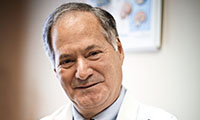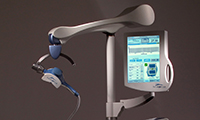NeuroStar TMS Therapy
Zapping Away Depression: Magnetic Pulses May Provide New Hope for Individuals Suffering From Psychiatric Disorders
Transcranial Magnetic Stimulation (TMS), which generates small bursts of MRI-strength magnetic energy that stimulate nerve cells in the brain, has shown success in easing depression when used on an area of the brain linked to mood.
Charles M. Epstein, MD, neurologist and founder/director of the Laboratory for Magnetic Stimulation at Emory University, co-invented the core technology for NeuroStar TMS Therapy®, the first TMS therapy to be approved by the FDA for the treatment of depression. NeuroStar® has been selected as a winner in the 2009 Medical Design Excellence Awards (MDEA), the leading awards program for the medical technology community.

Charles M. Epstein, MD
Neuronetics, the start-up medical device company created for the development of NeuroStar®, has safely administered more than 10,000 treatments with clinically significant results: among patients studied, 54 percent responded to the therapy and 33 percent found their depression in remission.
"The novelty of this technology is that it is non-surgical and non-invasive treatment," said Mark Coburn, of Emory's Office of Technology Transfer. "And its been shown to work in patients who have not responded to other treatments."
Despite being the second most prescribed drugs in the country, with more than 30 million americans taking them, antidepressants will not work for approximately 30% of those patients. Every year in the U.S., more than 30,000 people commit suicide, approximately 50 percent of whom suffered from major depression.
"The mental health community is enthusiastic," said Epstein. "Antidepressant medicine does not help everybody. Something else is needed." Electroshock therapy (ECT), though also a very effective treatment available for depression, is plagued by a number of unpleasant side effects, with memory impairment being the worst and most frequent.
TMS therapy, which first appeared in 1985, provides a much milder form of treatment that drastically reduces the chances of any serious side effects while still being able to help those individuals who have failed to respond to other treatments. Though seizures occur rarely with the use of TMS, none have arisen during treatment with NeuroStar®.

NeuroStar TMS System
The economic burden of depression in the U.S. is estimated at more than $80 billion annually. However, treatment with TMS therapy is much less expensive than electroshock. In addition, TMS does not require hospitalization as ECT often does.
Epstein relates his innovation to the switch from coal-burning engines to the steam turbines in trains. Like trains, TMS therapy existed prior to NeuroStar. What changed was the method by which the energy was generated. Epstein found a more efficient way to produce magnetic fields using a smaller device that requires less energy, produces less heat, and lower costs.
As a result of its effectiveness and ability to save money and limit morbidity, NeuroStar® provides a more practical method for combating the climbing rates of mental illness.
"My hope is that this technology will make millions of people better and not harm a single one," said Epstein.
There is a series of blog pieces that accompany the patient centered video project linked above on this technology.